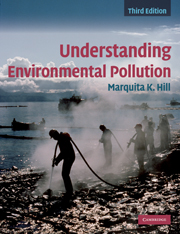Book contents
- Frontmatter
- Contents
- Preface
- Acknowledgements
- List of abbreviations and acronyms
- 1 Understanding pollution
- 2 Reducing risk, reducing pollution
- 3 Chemical toxicity
- 4 Chemical exposures and risk assessment
- 5 Air pollution
- 6 Acid deposition
- 7 Global climate change
- 8 Stratospheric ozone depletion
- 9 Water pollution
- 10 Drinking-water pollution
- 11 Solid waste
- 12 Hazardous waste
- 13 Energy
- 14 Persistent, bioaccumulative, and toxic
- 15 Metals
- 16 Pesticides
- 17 Pollution at home
- 18 Zero waste, zero emissions
- 19 Chemistry: some basic concepts
- Index
- References
17 - Pollution at home
Published online by Cambridge University Press: 05 June 2012
- Frontmatter
- Contents
- Preface
- Acknowledgements
- List of abbreviations and acronyms
- 1 Understanding pollution
- 2 Reducing risk, reducing pollution
- 3 Chemical toxicity
- 4 Chemical exposures and risk assessment
- 5 Air pollution
- 6 Acid deposition
- 7 Global climate change
- 8 Stratospheric ozone depletion
- 9 Water pollution
- 10 Drinking-water pollution
- 11 Solid waste
- 12 Hazardous waste
- 13 Energy
- 14 Persistent, bioaccumulative, and toxic
- 15 Metals
- 16 Pesticides
- 17 Pollution at home
- 18 Zero waste, zero emissions
- 19 Chemistry: some basic concepts
- Index
- References
Summary
“Seeing things differently is the first step toward doing things differently.”
Anon.Thirty years ago, the US EPA, working with Harvard University was studying the sources of various environmental pollutants. They made what was then a startling observation: regardless of the community studied – its location, whether rural or urban, lightly or highly industrialized, and regardless of sex, age, smoking habits, and occupation – indoor air pollution was the major source of exposure to many air pollutants. This is perhaps not surprising: Most people spend 90% or more of their time indoors, indoor sources emit many of the same pollutants as outdoors sources, and dilution with outdoor air may be slow to occur. In the following years, the Advisory Board of the US EPA ranked indoor air pollution as a priority environmental health risk. ▪ Section I of this chapter reviews specific contaminants that impact indoor air quality: combustion pollutants (including tobacco smoke), volatile organic chemicals (VOCs), radon and biological pollutants. It also examines health impacts of combustion particulates on people in less-developed countries. Section II delves into hazardous household products and household hazardous waste, and describes two old hazards that remain with us, asbestos and lead paint.
SECTION I
Indoor air pollution
Contaminants affecting indoor air quality spring from many sources (Table 17.1). To fully understand Figure 17.1, go to URL in footnote and, one-by-one click each room shown.
Combustion appliances including wood stoves and fireplaces, gas stoves, and kerosene heaters emit particulates and several criteria air pollutants (Chapter 5).
[…]
- Type
- Chapter
- Information
- Understanding Environmental Pollution , pp. 483 - 510Publisher: Cambridge University PressPrint publication year: 2010



